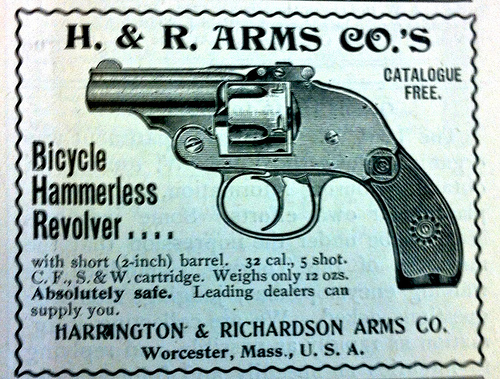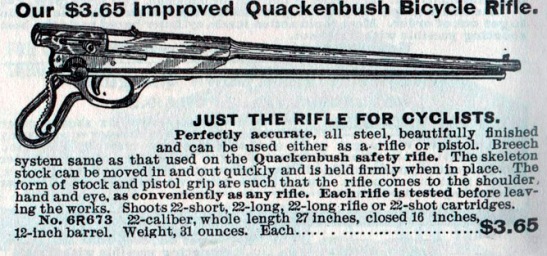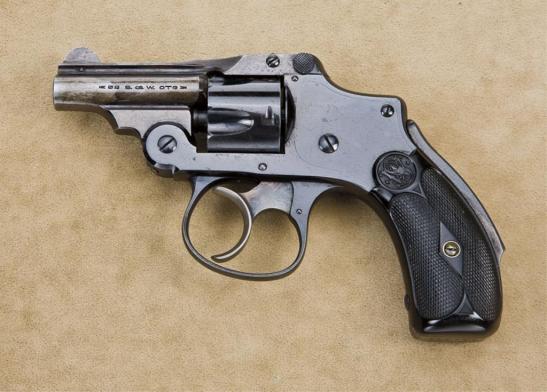Guns, Wheels, and Steel: Cyclists and Small Arms in the Late 19th Century
A few weeks ago Jean, who writes at Cycle Write Blog wrote an interesting piece on stereotypes of cyclists and how these perceptions ignore the fact that, like car drivers, cyclists are not a homogenous group but represent all walks of life and all manner of viewpoints. In the piece Jean briefly commented on gun ownership among modern-day cyclists, which reminded me of this late nineteenth-century advert for a, “lovely little shooter”, from the English gun factor, T. W. Carryer & Company, Limited, that carried the tag-line, “I fear no tramp.”
Safety on the highways and byways of the United Kingdom was a more significant issue for the late nineteenth-century public and police than it is today, and adverts for small arms such as these catered for the demands of those who wished to protect themselves against perceived risk when out and about. A fear that was captured by the Whitstable Times and Herne Bay Herald in an imagined encounter of 1900:
Tramp: “Excuse me; have you seen a policeman?”
Cyclist: “No.”
Tramp: “Then I’ll have to call on you to give up your watch and money.” [1]
Perceptions of risk often exaggerate the reality, yet the risk of robbery or assault on the roads was a real one, as the newspapers of the time were happy to report. In Liverpool in 1895 three youths, Richard Hart, Christopher Welsh, and Snowden Badger (a name to conjure with) were charged with assaulting and robbing Margaret Howcroft by knocking her from her bicycle and stealing her satchel which contained the day’s takings from the shop of which Margaret was the manager [2]
In 1897 Esther Gray, a teacher at Whittlebury School in Towcester, was assaulted by a tramp named Martin Gallaher when she was cycling on roads just outside the town. Gallaher, armed with a knife, had made at her before she jumped off her bicycle and fled the scene. A passer-by, John Faulkner, attempted to stop Gallaher but was wounded in the attempt. Gallaher fled but was arrested by a police-inspector before he could make good on his escape [3].
A year later a Mr. Bamfield was attacked by two men while riding from Birmingham to Bromsgrove at the hour of midnight. Knocked unconscious by a violent blow to the head, he was left insensible in a ditch by his attackers who stole his watch, money, and bicycle [4]. A few days later his bicycle and watch were found discarded in a wood nearby. Curiously the police reported that they had not been there when the wood had been searched on the day following the robbery [5].
Elsewhere in 1898, Miss Hill, of Sharpenhoe Road, Luton, was attacked by two tramps who threw her to the ground and sought to drug her with an unidentified concoction before rifling her dress and stealing her purse which contained the princely sum of 2 shillings and 1 pence [6]. Later that year John White, a joiner from Newcastle, was assaulted by a group of tramps who appear to have taken umbrage at his ringing his bicycle bell while they were blocking the road. After letting him through one of the men seized his front wheel sending him crashing to the ground and knocking him out. No robbery occurred but White was left with bruising and a split knee cap [7].
With risks such as these to contend with it is perhaps understandable why some cyclists sought to arm themselves for protection, and why arms manufacturers produced specific designs for cyclists use. And it should perhaps be remembered that robbery and assault were not the only scenario’s where a handy firearm might be of use. Arguably firing a small revolver at any of the many cows, bulls, and oxen that threatened cyclists between 1880 and 1900 would not have been a good idea had any cyclist decided to do so. Not only would it probably have been ineffective, it would no doubt have led to a court case from an irate farmer, and a hefty fine for the pistol packing bike rider.
Dogs on the other hand were fairer game as well as a hazard, as in 1896 when Miss Spencer and Miss Taylor of Dalston were attacked and bitten by an alleged mad dog, requiring them to visit the Pasteur Institute in Paris for treatment [8]. In 1893 Thomas Cattell of Tanworth was physically uninjured when he shot dead a terrier that ran at him while he was cycling. Financial injury occurred however, when the Petty Sessions magistrate imposed fines, damages and costs of £10, 16 shillings and 6 pence on Cattell for killing the dog which was valued at £10 [9]. Whether to use violence on a dog was clearly a matter for careful consideration for any cyclist in Britain as a Welsh cyclist found to his cost in 1898 when he was fined for kicking a dog that had attacked him when he went to the rescue of a lady whom the dog was menacing [10].
Smaller mammals could also threaten a rider’s safety as a Scottish gentleman discovered in 1897 when he achieved some small fame under the eye-catching headline, “Cyclist Attacked By Weasels”. A “swarm” of them apparently having jumped him while he pushed his bike up a hill late at night. Abandoning the bike, and presumably his dignity, he fled the scene and was later treated for bite wounds to his hand by a local doctor [11]. Even if the gentleman had been carrying a pistol one imagines it wouldn’t have been of much use, as shooting weasels in the dark is no mean feat of marksmanship.
For those cyclist’s who didn’t want to physically injure or kill a fellow human being, or an animal, there were alternatives available. In America just 50 cents would buy you a “Liquid Pistol” for “protection against dogs or men, without killing or maiming.” Importantly using it wouldn’t break any law, or create “lasting regrets”. It’s inventor, Russell Parker, advocated ammonia as the liquid of choice against vicious dogs, footpads, thieves, tramps, robbers and toughs [12]. Toxic and corrosive, a few drops of ammonia to the face would certainly have been enough to discourage most attackers, at least for long enough for the cyclist to make a getaway.
Those who wanted heavier firepower had several choices in addition to the ‘Cyclist’s Friend’. The well known small arms manufacturer Smith & Wesson produced a specially adapted short-barrelled version of their hammerless revolver for cyclists, as did the Harrington & Richardson Arms Company.
While the J. Stevens Arms and Tool Company and Quackenbush both produced long-barrelled revolvers with detachable rifle stocks with designs that solved the problem of carrying a proper rifle on a bicycle, albeit by sacrificing overall accuracy.
In France cyclists were offered Le Revolver-Cycle, a small six barrelled pistol that fired 5 millimetre ball and could be housed in the end of the handlebars, ready to whip out and fire when needed.
If cyclists could carry arms, whether lethal or not, they were also the frequent victims of other gun owners. In many cases they were accidental victims, but on occasion they were deliberately targeted. In 1900 two boys named as Redpath and Crossland were charged with shooting at a cyclist near Bridlington with the intent of puncturing his tyres. They were probably lucky that no serious injury, or death, was caused as the police found a bullet from the guns they used had lodged in the wainscotting of a nearby building [13].
In 1898 a constable at Cheshunt police station observed a young man staggering along the road wheeling his bicycle. Assuming over-indulgence to be the cause the policeman approached the man only to be told that he had been the victim of a robbery and had been shot. His assailant had waylaid him on the road by springing out from a hedge, clapping a pistol to the man’s chest and shooting him on the spot before rifling his pockets and stealing the sum of 5 shillings and sixpence [14].
In 1895 a cyclist named Loveley was accosted by two men, also on bicycles, on the road between Doncaster and York. Challenged with the classic, “Your money or your life!”, Loveley put his foot down but as he sped away was struck by a bullet. Reaching York he was conveyed to the hospital where a bullet was found lodged in his thigh. [15]
More typically cyclist’s were the victim of accidental shootings, as was the case for John Williams, who while riding through Cradley, Worcestershire, in 1900 was shot when a muzzle loaded gun was accidentally discharged as he rode by, leaving Williams with sixty or seventy pieces of shot in his back [16]. A year earlier George Sedgwick of London was accidentally shot by a party of sportsmen near Market Drayton who he thought had mistaken his white silk cap for a bird. Sadly the sportsmen offered little aid despite Sedgwick suffering from nine shots in his back, one in his arm, and four or five in his head, one of which had penetrated his jaw and knocked out a tooth [17].
And on occasions cyclists were their own victims, as was the case for John Bacon of Russiaville, Indiana, when his revolver caught against the seat spring as he mounted his bicycle, sending a ball into his hip and through his leg as far as the knee. Fortunately for Bacon it was reported that he would recover [18].
Based on the evidence of late nineteenth century Britain and elsewhere, it’s arguable that guns and cycling were not a particularly complimentary mix of technologies. While carrying a revolver may have given the owner a sense of security, the risk of being robbed at gunpoint, or even shot, was relatively low. In many instances it was cyclists themselves who were the perpetrators, rather than the victims, of crime, the bicycle offering a means of a speedy getaway after armed robbery. In a few instances they were guilty of murder, as in the sad case of the shooting of 8 year old George Borgher in Maynard, Iowa, in 1898. George was shot dead by an unknown cyclist who took umbrage at comments about his appearance made by the boy [19].
Murder was fortunately rare, whether perpetrated against or by cyclists. Such killings were outnumbered by the suicides among cyclists, several of which were reported in the contemporary press. Typically these were young men, presumably suffering from depression or other psychological conditions, who were found dead by their own hands in hotel rooms. Murder and suicide aside, it would seem that rather than being the frequent victims of deliberately targeted attacks the biggest gun risk to cyclists in the period were from huntsmen or hunting parties who were unaware of the cyclist’s presence when firing.
Small arms designed, or perhaps more accurately marketed for cyclists, appear to have been a relatively short lived phenomenon. In part this may have been the inevitable result of the expansion and growth in car ownership and the consequent decline in bicycle ownership and use. Increasing public safety on the roads in the twentieth century, and in England the growing controls on gun ownership that began with The Pistols Act 1903, also played its part. Today, to British sensibilities at least, the connection between guns and bicycles seems a strange one. And as far as can be ascertained no modern day small arms manufacturer produces a pistol that they explicitly market as being suitable for cyclists. Those so inclined may, however, choose from a variety of small lightweight handguns if they really, really want to carry a gun. Personally I’d suggest that working a little harder during training so you can use the bike to speed away from confrontation is a better idea.
______
Footnotes:
- “Lady cyclist attacked,” Sheffield Evening Telegraph, October 5, 1895, 3.
- Whitstable Times and Herne Bay Herald, April 14, 1900, 6.
- “Attack on a lady cyclist,” Gloucester Citizen, September 14, 1897, 3.
- “Cyclist attacked by highwaymen,” Sunderland Daily Echo and Shipping Gazette, July 14 1898, 4.
- “The highway robbery of a cyclist,” Dundee Courier, July 16, 1898.
- “Lady cyclist robbed at Kensworth,” Luton Times and Advertiser, July 15, 1898, 5.
- “Cyclist attacked by tramps,” Sunderland Daily Echo and Shipping Gazette, August 18, 1898, 4.
- “Lady cyclists attacked by mad dog,” Edinburgh Evening News, April 22, 1896, 3.
- “The cyclist and the dog,” Sheffield Evening Telegraph, September 14, 1893, 4.
- “Cycling news & gossip,” Pontypridd Chronicle and Workman’s News, July 29, 1898, 3.
- “Cyclist attacked by Weasels,” Edinburgh Evening News, September 01, 1897, 2.
- “Bicyclists need a liquid pistol,” Republican News Item (Laport, Pa.), August 25, 1898; US Patent 600552, March 15, 1898.
- “Shooting at cyclists,” Nottingham Evening Post, October 22, 1900, 4.
- “Cyclist shot: Highway robbery and attempted murder,” Evening Express, November 22, 1898, 3.
- “Cyclist shot by a cyclist,” Evening Express, April 19, 1895, 2.
- ” A cyclist shot at Cradley,” Cheltenham Chronicle, September 15, 1900, 6.
- “Shooting at a cyclist,” Nottingham Evening Post, September 17, 1889, 2.
- “A cyclist shot himself,” Indianapolis Journal (Indianapolis, Ind.), June 25, 1894, 2.
- “Shot by a cyclist: 8 year old boy murdered on the highway,” The Topeka State journal. (Topeka, Kan.), August 10, 1898, 5.










This is an incredible piece of research for a topic in cycling history, Aaron! Especially all the incidents you have documented, different guns, etc. Was it hard to find this stuff? Must have taken you a few months..
LikeLiked by 1 person
Thanks Jean, glad you enjoyed it. I have a subscription to the British Library British Newspaper Archive (£50 a year I think), and the Library of Congress, Welsh National Library, and Australian and New Zealand have very extensive newspaper archives online which are free at the point of access. Great resources, and as they are fully searchable it’s easier than one might think to find interesting material. I started this piece on Tuesday so it didn’t take long. And as usual there’re other articles on the web about the subject. Hopefully by using the newspaper articles I’ve added a little to what’s already out there.
LikeLiked by 1 person
You have made it easier by writing that blog post, Aaron. A faithful library researcher: I am by formal training and career-wise a librarian in the engineering, law and govn’t sectors. 🙂 You understand the value of those humungous electronic subscriptions that libraries provide to users.
LikeLike
Pingback: Cycling Patents of Yesteryear: No. 7 – Evan S. Connell Jr’s Bicycle Attached Toy Machine Gun, 1951 | Cycling History
Reblogged this on The Road to Revelation and commented:
Some more interesting bicycling history
LikeLiked by 1 person
Excellent historical reference…but your final photo labeled “an example of an Iver Johnson Cycle revolver”…is a Smith and Wesson. The SW logo is on the grip plate and Iver Johnson didn’t make a “lemon squeezer” grip safety.
LikeLike
Thanks for the correction Will. A handy reminder of the need to double check one’s sources. I will make the necessary amendments.
LikeLike
Fascinating stuff, I have just shared it to my Facebook “civilised cycling” group so you will get a lot more readers today! I too have a subscription to the British Newspaper Archive so I will do a bit of digging there myself over Christmas when I get time.
LikeLike